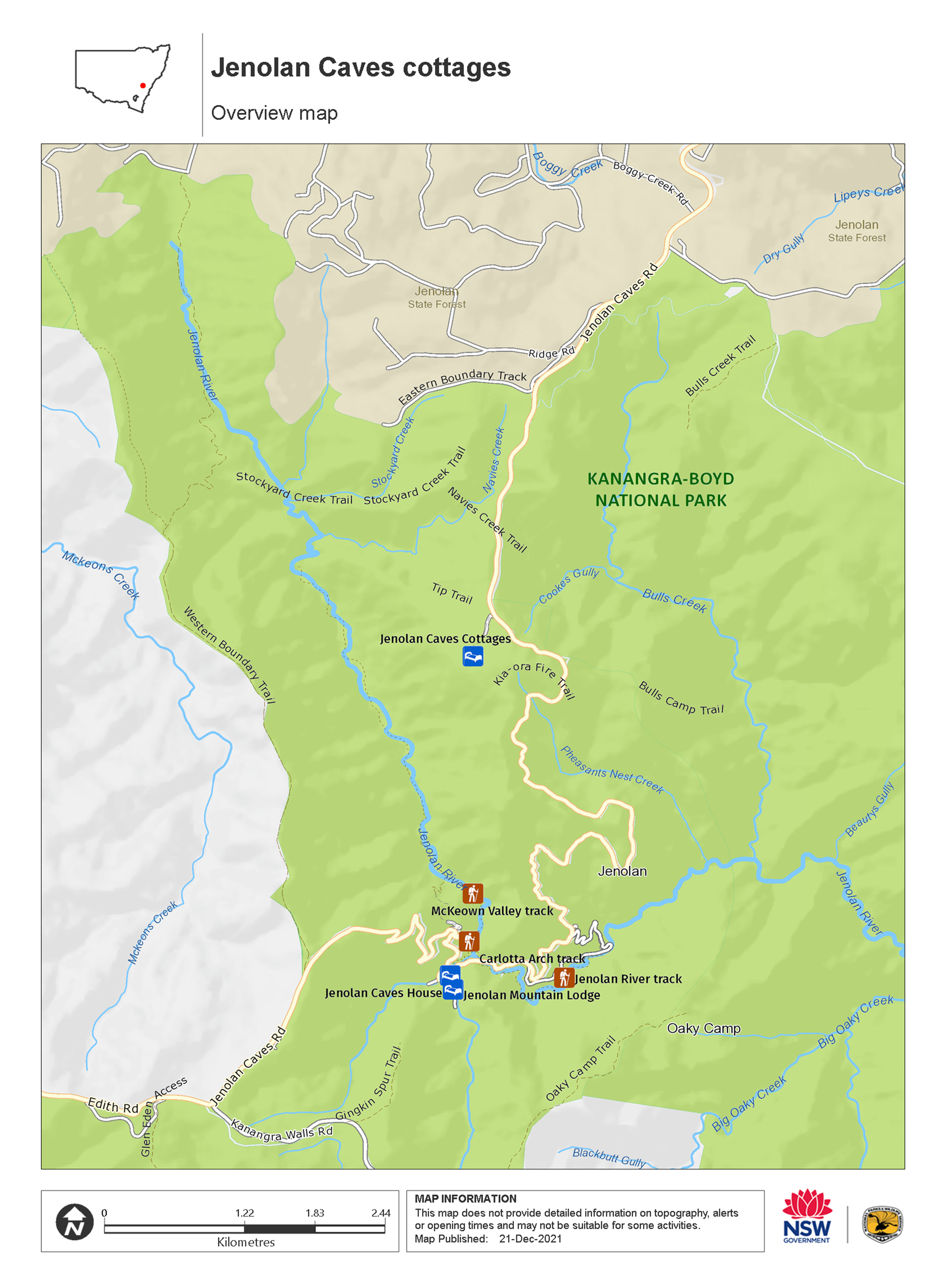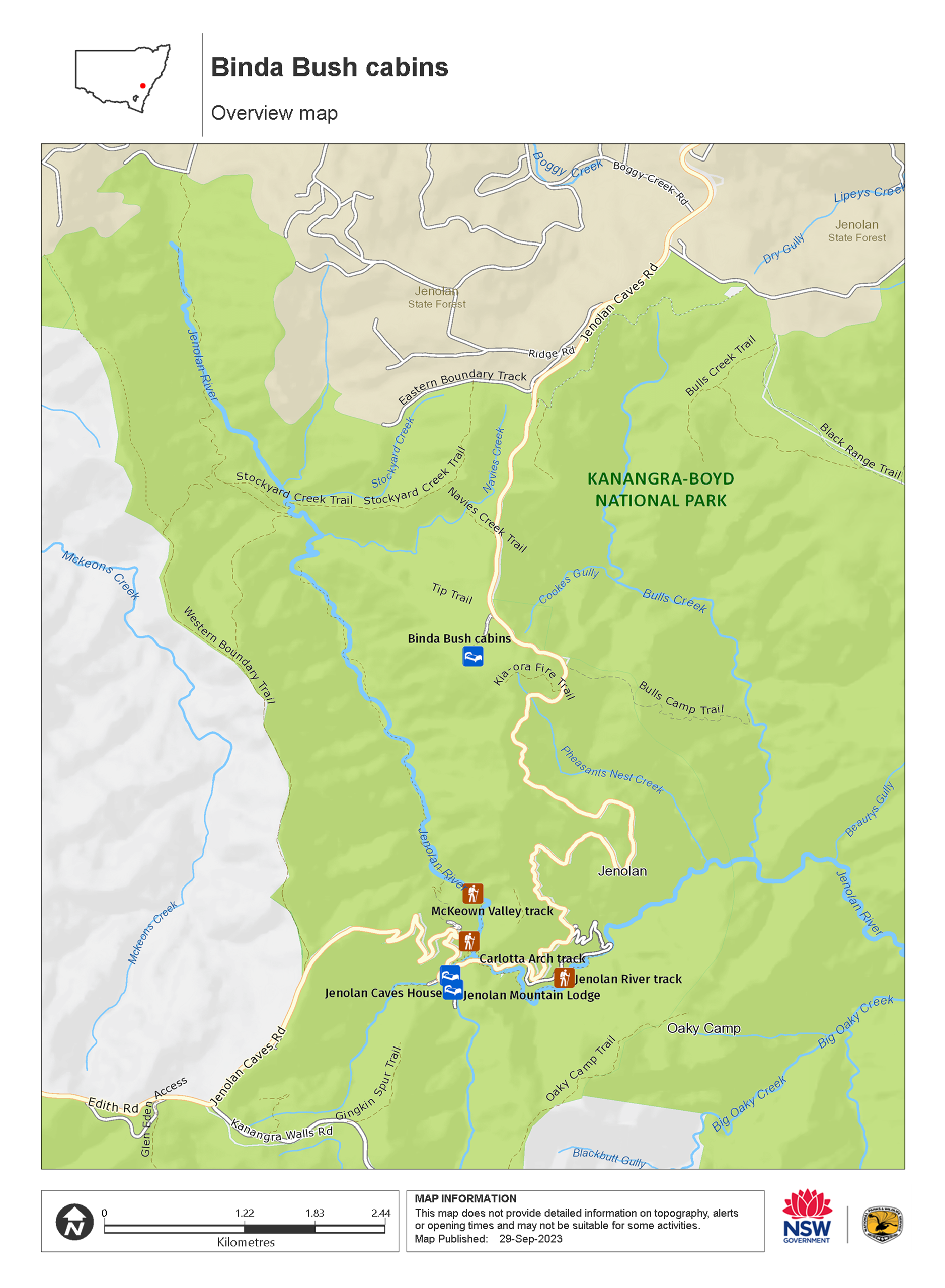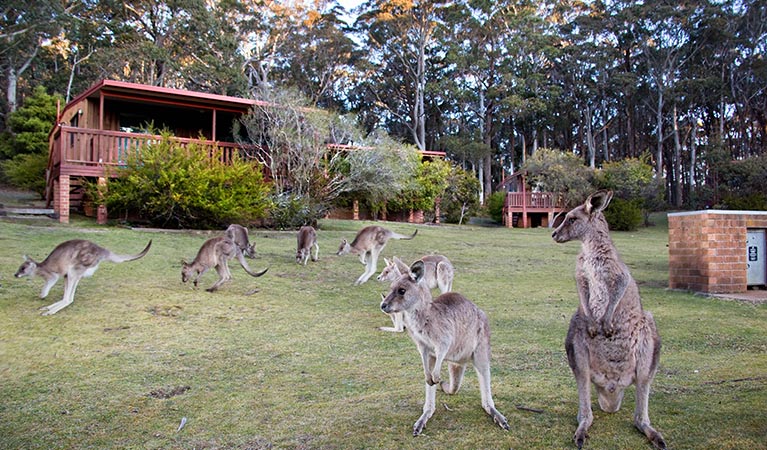Binda Bush cabins
Jenolan Karst Conservation Reserve
Overview
Binda Bush cabins are closed for road repairs and upgrades until 2026.
| Accommodation type | Cottage |
|---|---|
| Where | 3782 Jenolan Caves Road, Jenolan, NSW, 2790 - in Jenolan Karst Conservation Reserve |
| Bedrooms | 2 |
| Maximum guests | 6 |
| Facilities | Toilets, showers, picnic tables, barbecue facilities, carpark, drinking water, electric power |
| What to bring | Bed sheets, blankets, pillow cases, pillows, towels |
| Please note |
|
Jenolan Karst Conservation Reserve is closed until 2026 while Transport for NSW repairs flood-damaged roads and landslips. During this time, NPWS and Jenolan Caves Trust will also work to upgrade the accommodation, walking tracks and access to caves.
Nestled in natural bushland, the recently renovated Binda Bush cabins make a great base for exploring Jenolan Caves, or for any trip to the Greater Blue Mountains Area World Heritage Property. Located 3 hours from Sydney or Canberra, the self-contained cottages each have 2 bedrooms and sleep up to 6 people.
There’s plenty to do nearby to keep the family busy, from awe-inspiring cave tours to walking tracks with views of natural arches and waterfalls. When you’re done exploring, come back and relax on your cottage verandah with a drink. Keep an eye out for lyrebirds, and kangaroos that come to graze on the surrounding grass.
Have a friendly BBQ on the verandah while the kids work up an appetite in the playground. In cooler weather, cook up a cosy feast indoors while the family stays warm in the glow of your common room’s stove. For a big night out, try Chisholm's Restaurant at Jenolan Caves House. It takes 40min to drive from the cabins to Jenolan Caves.
When you’re rested and ready for something different, head to Hartley Historic Site to see its cottages, gallery and café.
Map

Map legend

Map

Local alerts
For the latest updates on fires, closures and other alerts in this area, see https://www.nationalparks.nsw.gov.au/camping-and-accommodation/accommodation/binda-bush-cabins/local-alerts
General enquiries
- National Parks Contact Centre
- 7am to 7pm daily
- 1300 072 757 (13000 PARKS) for the cost of a local call within Australia excluding mobiles
- parks.info@environment.nsw.gov.au
Operated by
- Jenolan Caves
- 1300 76 33 11 or
- 02 6359 3911 within Australia
- +61 2 6359 3911 International
- reception@jenolancaves.org.au
- 4655 Jenolan Caves Road, Jenolan Caves NSW 2790
Park info
- in Jenolan Karst Conservation Reserve in the Sydney and surrounds region
This reserve is closed until 2026. For more information, check the Jenolan Caves website.
Visitor info
All the practical information you need to know about Binda Bush cabins.
Maps and downloads
Learn more
Binda Bush cabins is in Jenolan Karst Conservation Reserve. Here are just some of the reasons why this park is special:
Binomil

The beautiful and mysterious Jenolan Caves holds special significance to the Gundungurra people who knew it as 'Binoomea' meaning 'dark places'. According to Gundungurra Elder, Old Jimmy Lynch, Aboriginal people knew the caves, carrying sick people as far as the subterranean water which they believed to have great curative powers. The Dreamtime myth of Gurrangatch relates to the forming of Wombeyan and Jenolan Caves. The caves are said to have been formed during a contest between Gurrangatch, a mythical being that was part fish and part reptile, and Mirragan, a legendary tiger cat.
Greater Blue Mountains Area World Heritage Property

It is truly amazing to think that a city the size of Sydney has a large World Heritage Area on its doorstep. The World Heritage listing recognises the geographic, botanic and cultural values of the area. The forests of the Greater Blue Mountains Area World Heritage Property have been described as a natural laboratory for the evolution of eucalypts; and more than 90 different eucalypt species occur here, some 13 per cent of all eucalypt species in the world. They grow in a great variety of communities, from tall closed forests, through open forests and woodlands, to the stunted mallee shrublands on the plateaus.
Historic tourism

Jenolan Caves is one of Australia's first tourist attractions; with land having first been set aside for public recreation and enjoyment in 1866. In the years following this, a number of buildings were constructed, the most notable being Caves House; an excellent example of early Victorian architecture and comfortable heritage accommodation. Innovations in engineering and cave lighting are evident - particularly in Chifley Cave. There are more than 300 caves within the Reserve, all containing a range of geological features and formations, like stalactites and stalagmites, plus rarer helictites and stromatolites The best way to find out about the caves is on a guided or self-guided tour. There are eleven caves to choose from.
- Jenolan River walking track Jenolan River walking track and Blue Lake are closed for road repairs and upgrades until 2026.
- McKeown's Valley walking track McKeown's Valley walking track is closed for road repairs and upgrades until 2026.
Plants and animals protected in this park
Animals
-

Eastern bentwing-bat (Miniopterus schreibersii oceanensis)
Eastern bentwing-bats congregate in caves across the east and north-west coasts of Australia, in colonies of up to 150,000. These small Australian animals weigh around 13-17g and can reach speeds of up to 50km per hour. Eastern bentwing-bats use both sight and echolocation to catch small insects mid-air.
-

Platypus (Ornithorhynchus anatinus)
One of the most fascinating and unusual Australian animals, the duck-billed platypus, along with the echidna, are the only known monotremes, or egg-laying mammals, in existence. The platypus is generally found in permanent river systems and lakes in southern and eastern NSW and east and west of the Great Dividing Range.
-

Common brushtail possum (Trichosurus vulpecula)
One of the most widespread of Australian tree-dwelling marsupials, the common brushtail possum is found across most of NSW in woodlands, rainforests and urban areas. With strong claws, a prehensile tail and opposable digits, these native Australian animals are well-adapted for life amongst the trees.
-

Bare-nosed wombat (Vombatus ursinus)
A large, squat marsupial, the Australian bare-nosed wombat is a burrowing mammal found in coastal forests and mountain ranges across NSW and Victoria. The only other remaining species of wombat in NSW, the endangered southern hairy-nosed wombat, was considered extinct until relatively recently.
-

Short-beaked echidna (Tachyglossus aculeatus)
One of only 2 egg-laying mammals in the world, the short-beaked echidna is one of the most widespread of Australian native animals. Covered in spines, or quills, they’re equipped with a keen sense of smell and a tube-like snout which they use to break apart termite mounds in search of ants.
-

Spotted-tailed quoll (Dasyurus maculatus)
The spotted-tailed quoll is the largest remaining carnivorous marsupial on the Australian mainland. It’s protected as a vulnerable species in NSW.

